Journal of Digital Technologies and Law
Статьи журнала - Journal of Digital Technologies and Law
Все статьи: 206
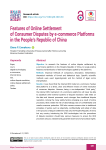
Статья научная
Objective: to research the features of online dispute settlement by e-commerce platforms in the People’s Republic of China, to reveal positive features and drawbacks of ODS technologies applied by the platforms. Methods: empirical methods of comparison, description, interpretation; theoretical methods of formal and dialectical logic. Specific scientific methods were used: legal-dogmatic and the method of legal norms interpretation. Results: it was found that the internal ODS model on e-commerce Taobao ODS platforms is a direct, clear and effective means of online resolution of consumer disputes. However, being a non-independent “third party”, the internal ODS mechanism of e-commerce platforms will never be able to substitute other external systems of dispute resolution. ODS relies on the data and Internet processes much stronger than traditional dispute resolution. Among the many safety factors emerging as a result of online processes, ODS creates the risk of data leakage, lack of confidentiality and unsafe consumer protection. ODS also causes concerns due to traditional principles of justice such as objectivity, confidentiality and safety of data in the process of dispute settlement. Not only the People’s Republic of China but any country introducing the ODS technologies into the procedures of dispute resolution should take serious measures to ensure the ODS processes are just, unbiased and guarantee observance of procedural rights. Scientific novelty: consists in a complex research of online dispute settlement by e-commerce platforms in the People’s Republic of China, the practice of implementation thereof has its specific features stemming from the model of self-regulation of thee relations, further stipulated by normative legal acts of the People’s Republic of China and reflected in the activity of private ODS platforms. Practical significance: is due to the current absence of possibility to apply the legal norms and rules, taking into account the specific features of ODS technologies on private platforms, to the relations using such technologies. The main provisions and conclusions of the research can be used to improve the mechanisms of legal regulation of ODS technologies in the procedural legislation of the Russian Federation.
Бесплатно
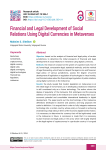
Financial and Legal Development of Social Relations Using Digital Currencies in Metaverses
Статья
Objective: based on the analysis of financial and legal policy of certain jurisdictions, to determine the initial prospects of financial and legal development of social relations in metaverse using digital currencies. Methods: the research is based on the system of cognitive tools: first of all, formal-legal, comparative-legal, statistical methods, and the method of legal forecasting, which help to interpret the legal norms and financial-legal policy of various jurisdictions, assess the degree of current development of legislation on regulation of technologies in virtual worlds, and formulate ideas about the financial-legal regulation of public relations using digital currencies in the metaverse. Results: the study reveals that modern legislation on metaverses is at the initial stage of its formation, as in developed jurisdictions metaverse is still considered only as a future technology. The author shows the degree of popularity of the metaverse first prototypes and the growing attention of some states to the metaverse in order to develop their socio-economic potential and consolidate international leadership in digital development. The paper points out the shortcomings of the metaverse definitions developed in doctrine and practice, and long proposes the author’s definition. It is argued that in order to fully integrate metaverse technology into a certain country, whose policy is focused on achieving (maintaining) a high rating in terms of the economy digital transformation, it is necessary to determine the currency that will be legitimately used in the metaverse in future. A conclusion is made that it is necessary to plan financial and legal policy in this area, which will largely depend on the legal regime of cryptocurrency in a particular country. It is argued that further development of the metaverse concept in Russia will depend on the results of testing the digital ruble. Scientific novelty: the paper is one of the first devoted to the convergence of metaverse and financial law, which proposes a concept for establishing full-fledged legality of digital currency in the metaverse depending on the attitude of a particular country to decentralized finance. Along with popular definitions formulated in doctrine and practice, the author presents their own interpretation of the metaverse, indicating its essential features. Practical significance: the conclusions and proposals obtained can be used to improve the mechanisms of financial and legal regulation of social relations under the emerging metaverse concept. The presented ideas are important for further research of various financial and legal aspects of metaverses’ development and functioning.
Бесплатно
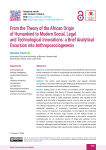
Статья
Objective: to trace the evolution of humanity and to identify the role of various social institutions in order to understand the existential role of laws aimed at ensuring the coexistence of society in the context of technological innovations. Methods: the author used general scientific and special methods of cognition, which allowed tracing the dialectical development of humanity, social transformations and technological innovations. Results: looking back at the history of humanity, which originated on the African continent (the theory of African descent), the author notes the most important changes in the human way of life and environment, which led to the need to build organized societies and regulate social behavior with the help of legislative norms. Law is seen as part of the evolutionary process that was to emerge in the course of human evolution. The critical importance of law in overcoming the global challenges and existential questions of humanity’s continued coexistence arising in the course of evolution is emphasized. In this regard, the historical significance of the Kurukan Fuga Charter of the Malian Empire is emphasized as one of the oldest constitutions in the world, recognized internationally as an important source of legal and political norms for modern societies, regulating the structure of state power and social behaviour, although preserved largely in oral form. It is argued that social and technological change often served as the impetus for the development of new laws. Humanity has many times intervened in its own biological evolution with the help of technology; now it is an important moment from the viewpoint of law and ethics when technology may interfere in further human evolution. The greatest concern in this regard is the era of rapid development of artificial intelligence, which makes new demands on a human being. Scientific novelty: the article shows the role of the African continent in the origin and development of humanity and socio-legal institutions in the light of modern transformations and the construction of a new social reality. Practical significance: the conducted research creates prerequisites for further development of the theory of anthroposociogenesis and in-depth conceptual historical and legal study of the role of the African continent in the development of humanity and its social institutions.
Бесплатно
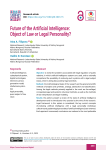
Future of the Artificial Intelligence: Object of Law or Legal Personality?
Статья научная
Objective: to reveal the problems associated with legal regulation of public relations, in which artificial intelligence systems are used, and to rationally comprehend the possibility of endowing such systems with a legal subject status, which is being discussed by legal scientists. Methods: the methodological basis of the research are the general scientific methods of analysis and synthesis, analogy, abstraction and classification. Among the legal methods primarily applied in the work are formal-legal, comparative-legal and systemic-structural methods, as well as the methods of law interpretation and legal modeling. Results: the authors present a review of the state of artificial intelligence development and its introduction into practice by the time of the research. Legal framework in this sphere is considered; the key current concepts of endowing artificial intelligence with a legal personality (individual, collective and gradient legal personality of artificial intelligence) are reviewed. Each approach is assessed; conclusions are made as to the most preferable amendments in the current legislation, which ceases to correspond to the reality. The growing inconsistency is due to the accelerated development of artificial intelligence and its spreading in various sectors of economy, social sphere, and in the nearest future – in public management. All this testifies to the increased risk of a break between legal matter and the changing social reality. Scientific novelty: scientific approaches are classified which endow artificial intelligence with a legal personality. Within each approach, the key moments are identified, the use of which will allow in the future creating legal constructs based on combinations, avoiding extremes and observing the balance between the interests of all parties. The optimal variant to define the legal status of artificial intelligence might be to include intellectual systems into a list of civil rights objects, but differentiating the legal regulation of artificial intelligence as an object of law and an “electronic agent” as a quasi subject of law. The demarcation line should be drawn depending on the functional differences between intellectual systems, while not only a robot but also a virtual intellectual system can be considered an “electronic agent”. Practical significance: the research materials can be used when preparing proposals for making amendments and additions to the current legislation, as well as when elaborating academic course and writing tutorials on the topics related to regulation of using artificial intelligence.
Бесплатно
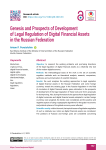
Статья научная
Objective: to research the existing problems and promising directions of the legal regulation of digital financial assets as a relatively new tool of the modern digital economy. Methods: the methodological basis of the work is the set of scientific cognition methods such as theoretical analysis, research, comparison, synthesis, and summarization of scientific literature. Results: the work analyzes the existing approaches to legal regulation of digital financial assets in the Russian Federation and some foreign countries, reveals the existing gaps in the Russian legislation in the field of circulation of digital financial assets, gives estimation to the prospects of development of the legal regulation of these tools and forms proposals for its improving. Also, during the research, the approaches to legal regulation of digital currencies and digital financial assets, adopted in certain foreign countries, were analyzed, the trends were considered, and the positive and negative aspects of using cryptographic algorithms for the goals in economic and juridical spheres of the global economy were reflected. Scientific novelty: within the work, the topical issues of legislative regulation of such a relatively new notion as digital financial assets are considered. The positions of Russian and foreign jurist are considered concerning the existing problems and risks associated with “tokenization” and “blockachainization” of private law. Besides, the author comes to a conclusion about the existence of significant gaps in the current approach to legal regulation of digital financial assets, indicates them and proposes certain mechanisms to solve these problems. Practical significance: is due to the imperfect current legislation in the sphere of relations occurring when using the technologies based of distributed ledger, including digital financial assets. Research of these problems allows evaluating the risks, considering the existing ways of overcoming and solving the emerging disputable questions. Also, the conclusions obtained can be used to improve the Russian legislation, as well as in the academic literature devoted to the topical issues of developing the digital legislation.
Бесплатно
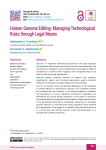
Human Genome Editing: Managing Technological Risks through Legal Means
Статья научная
Objective: to determine theoretical approaches to the legal regulation of reprogenetic editing, taking into account the risk-oriented approach and the practice of regulation of such breakthrough technologies in different jurisdictions; to outline further regulatory and managerial steps to be taken for the technology development. Methods: general scientific methods of analysis and synthesis, classification, system and functional approaches; specific scientific methods: formal-legal, comparative-legal, and historical-legal. Results: the research shows the possible approaches to the regulation of genetic editing for reproductive purposes. The considered variants are evaluated from the viewpoint of risk-oriented approach; conditions and peculiarities of various regulatory mechanisms’ application are determined; the current Russian regulation in this sphere is assessed. The analysis allows concluding that the prohibition or significant restriction of the developing technology of reprogenetic editing has no irrefutable grounds. Moreover, it may lead to the results opposite to those declared by its proponents. In this regard, it is necessary to develop the discussion in a constructive and iterative way and involve all stakeholders in it, including the scientific community. Scientific novelty: the international practice of legal regulation of reprogenetic technologies within different jurisdictions was generalized and conceptually interpreted; the natural scientific arguments in assessing the implemented regulation effectiveness were analyzed. This not only allows systematically considering the current and hypothetical risks of genetic technologies’ development and use, but also provides an opportunity to use a risk-oriented approach to the analysis of legal regulation of genome editing technologies. The next step in comprehending the phenomenon of genetic editing becomes possible. Practical significance: the study results can be used for building further constructive dialog on applying legal mechanisms to human genome editing. The study can also be a basis for iterative approach in the future discussion.
Бесплатно
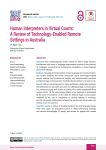
Human Interpreters in Virtual Courts: A Review of Technology-Enabled Remote Settings in Australia
Статья научная
Objective: This interdisciplinary review intends to inform legal scholars, practitioners, and users of language interpretation services in the judiciary of challenges encountered by professional interpreters in virtual hearings and remote settings. Methods: Situated at the intersection of law, language, and communication, this review analyses the latest discourses about technology-enabled remote settings and synthesises insights into recommended practices in effective legal communication mediated by interpreters in virtual courts. Results: With an overarching aim to improve effective collaboration between interpreting service providers and users in multilingual legal communication for procedural equity and access to justice, this review establishes three central claims: (1) the technology-enabled virtual hearings is accelerated by the covid-19 pandemic, (2) the need for effective legal communication mediated by the use of interpreters in remote settings is mounting, and (3) successful collaboration between the service user and provider can achieve a win-win outcome. Scientific novelty: A review of existing studies in law and language reveals three main gaps: (1) procedural justice in videoconferencing hearings and remote technologies, (2) equity and access for people with limited proficiency in the official language of the court system, and (3) effective legal communication mediated by human interpreters in virtual courts. This review bridges the existing gaps in knowledge. Practical significance: it touches on three aspects of the law-language nexus: (1) Covid-19 accelerated adoption of the virtual courtroom technologies in Australia and its impact on court interpreting, (2) challenges for interpreters in remote settings, and (3) achieving linguistic accuracy and intercultural appropriateness when preserving the manner in which the content is expressed as intended or implied by the original speaker. Grounded in courtroom interpreting practices, it highlights the importance of effective collaboration in successful multilingual legal communication rooted in mutual purpose, shared expectations, and interprofessional understanding.
Бесплатно
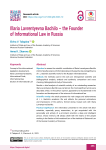
Illaria Lavrentyevna Bachilo – the Founder of Informational Law in Russia
Статья научная
Objective: to assess the scientific contribution of Illaria Lavrentyevna Bachilo into forming the science of informational law in Russia; the role and significance of I. L. Bachilo’s scientific works for the Russian informational law. Methods: the methods used in the work are: retrospective scientific and bibliographical analysis, analysis and synthesis, comparison and cross checking, bibliographical study of documents. Results: a brief analysis of scientific activity of an outstanding researcher Illaria Lavrentyevna Bachilo was carried out; the most significant works were described, which, in the authors’ opinion, appeared to be fundamental in the formation and development of the science of informational law. Scientific novelty: the article presents the main stages and achievements of I. L. Bachilo’s academic life and reflects the personal estimations and impressions of the authors, formed during mutual work with Illaria Lavrentyevna Bachilo. Practical significance: the information presented in the article will allow scientists, especially young researchers, to get acquainted with the personality and activity of a prominent scientist, a deep and intelligent person, whose memory will always dwell with the hearts of the people working in the Section of Informational Law of the Institute of State and Law of the Russian Academy of Sciences.
Бесплатно
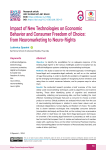
Статья
Objective: to identify the possibilities for an adequate response of the existing legal regime to the various challenges posed to European law by artificial intelligence systems underlying neuromarketing techniques. Methods: the study is based on the risk-oriented approach, formal-logical, formal-legal and comparative-legal methods, as well as on the method of legal forecasting, in order to identify the problems of legislation caused by the emerging technologies capable of recognizing human emotions and using them to control consumer behavior, and to propose ways to solve them. Results: the conducted research provides a brief overview of the most widely used neuromarketing techniques used by algorithms and machine learning. These allow identifying points of cognitive and emotional vulnerability, collecting and processing data, and then building the most effective marketing techniques that push a consumer to choose a certain product or service. Ethical problems are analyzed which arise from the use of neuromarketing techniques in relation to some basic values such as individual independence, human dignity, and freedom of choice. The subtle line is shown between techniques that manipulate consumer behavior (manipulation technique) and those that, on the contrary, have a persuasive effect, which in itself does not make them illegal (persuasion technique). An overview of the existing legal framework is presented, as well as case law from both the European Court of Justice and national courts of member states with a particular focus on the Unfair Commercial Practices Directive, the EU General Regulation on the Protection of Personal Data (hard law), and codes of ethics (soft law). Scientific novelty: the paper points out the transformation of traditional legal categories and important problem points of the existing regulation due to the growing recognition of the potential of neuromarketing as a tool capable of explaining and predicting consumer behavior, as well as influencing the economic behavior of the subjects of relations. Practical significance: the obtained conclusions and proposals can be taken into account in improving the regulation of artificial intelligence in terms of its safety and reliability, increasing trust in the system, given the need to protect ethical principles and maintain fundamental values.
Бесплатно
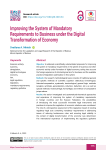
Статья научная
Objective: to elaborate scientifically substantiated proposals for improving the system of mandatory requirements in the sphere of business and other economic activity under formation of digital economy, taking into account the foreign experience of eliminating barriers for business and the available practice of legislation optimization in this sphere. Methods: the research methodological basis consists of traditional general and specific methods of scientific cognition: dialectical, formal-logical, historical-comparative, systematic, terminological, general logic methods (analysis, synthesis, generalization, induction, deduction, etc.), as well as special methods: historical-legal, formal-legal, and method of comparative jurisprudence. Results: the author investigated and systematized theoretical approaches and experience of improving the system of mandatory requirements in foreign countries and the Russian Federation; the possibilities of introducing the most successful innovative legal instruments and practices to improve the regulation of economic relations were considered. The role of a retrospective assessment of the regulatory impact of existing regulatory legal acts containing mandatory requirements in addressing issues of reducing burdensome rules and ensuring legal stability in the context of digital transformation of the economy was determined. The international experience of implementing the regulatory guillotine mechanism was considered; its essence, purpose, tasks, basic principles, and algorithm of operation were revealed. The issues of establishing and evaluating the application of the requirements for business contained in regulatory legal acts were analyzed. Scientific novelty: the author’s comprehensive analysis of existing scientific developments on improving the system of mandatory requirements for business; systematization of scientific and theoretical approaches to the selection of innovative legal instruments to eliminate excessive legal regulation of economic relations; generalization of successful foreign practices in the implementation of “regulatory guillotine” measures. Practical significance: recommendations were developed for effective reduction of burdensome requirements that negatively affect the development of business in the context of digital transformation of the economy. Conditions were determined for the implementation of a full-fledged regulatory impact assessment procedure and the successful implementation of regulatory reforms. The results of the study can be used in standard-setting activities and in the educational process when elaborating educational programs in Economics and Law.
Бесплатно
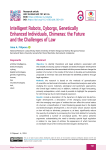
Статья
Objective: to identify theoretical and legal problems associated with the steadily increasing spread of digital and biotechnologies’ development products; to assess the risks associated with this process that can change the position of a human in the society of the future; to develop and substantiate proposals to minimize risks and eliminate the identified problems through legal regulation. Methods: the research is based on the methods of generalization of scientific and technical information and theoretical analysis used while studying the source materials; axiological and systematic approaches; the formal legal method and, in addition, methods of legal forecasting, primarily extrapolation, which made it possible to highlight the prospects for reforming law due to technological expansion. Results: include a description of the dynamics of digital and bio-technologies’ development; a description of the changing social landscape with the emerging new types of entities that can affect the actual status of a human; a classification of risks threatening people due to the digital and biotechnologies development; a list of tasks whose solution based on law will help to eliminate, postpone or, at least, significantly reduce the severity of problems by increasing the time limit allotted to humanity to comprehend a number of conceptual points. The author presents arguments substantiating the need to develop special legal regulation in relation to new types of entities, the appearance of which becomes an inevitable result of the mentioned technologies’ development. Scientific novelty: consists, first, in a comprehensive study of the development of interconnected groups of digital and biotechnologies, taking into account their increasing convergence; and, second, in the formulation of legal problems that need to be resolved due to the potential emergence of new types of entities with cognitive functions and capable of having a targeted intellectual impact on the environment and legal entities. Practical significance: it is present in the answers given to the formulated legal questions, which contain suggestions and recommendations on the necessary adjustment of legal regulation and focus the attention of legal scholars on the problems arising from the pace and vectors of science-consuming technologies’ development.
Бесплатно
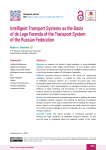
Статья научная
Objective: to research the trends of legal regulation of using intelligent transport systems under digital transformation of the transport sector of economy, namely, the growing importance of intelligent transport systems in the future transport system of the Russian Federation. Methods: systemic-structural method is the basis for researching intelligent transport systems. It enables to study the architecture of intelligent transport systems as a complex structural unity. Also, comparative-legal method was used, aimed at illustrating the differences and similarities in the legal regulation of intelligent transport systems. Methods of legal modeling and forecasting, as well as formal-logic method, served as secondary methods to comprehensively study the legal regulation of intelligent transport systems. Results: the article presents conceptual approaches to defining the notion of “intelligent transport systems” and outlining the hierarchy of intelligent transport systems, which play a fundamental role in building the transport sector. Based on the analysis, conclusions are made about the vectors of forming transport legislation, aimed at regulating the use of intelligent transport systems. Scientific novelty: the article provides a conceptual approach to forming the legal regulation of intelligent transport systems. To this end, the issue is considered about the essential content of the notion of “intelligent transport systems” at legal and scientific levels; the current terminological problems in building the legal regulation are shown. Analysis of the architecture of intelligent transport systems allowed for the first time to formulate the basic approaches to shaping the legal regulation of its individual elements (including highly automated and fully automated transport means, “smart” infrastructure, etc.) not in isolation but as constituent parts of the whole matter. Practical significance: the presented materials and conclusions facilitate the development of legal regulation of transport industry under digital transformation. The article accentuates the legal regulation of intelligent transport systems taking into account their technical and technological features. It is the intelligent transport systems that are de lege ferenda of the transport system, which determines the vector of transformation of transport legislation. In turn, development of the legal bases allows broadening the geography of introducing technical novelties and making their application much more large-scale.
Бесплатно
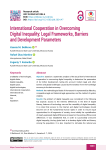
Статья
Objective: based on a systematic analysis of the actual level of international cooperation in overcoming digital inequality, to determine the parameters of its further development, taking into account modern legal and other barriers and global challenges caused by the transition from the knowledge economy to the data economy. Methods: the methodological basis of the research is represented by dialectics, comparative legal and historical legal approaches, and the method of system analysis. Results: the problem of digital inequality was considered in the following key aspects: access to the Internet; differences in the level of digital literacy; features of technology use and the versatility of digital inequality. It is noted that access to the Internet and digital technologies should become one of the fundamental human rights in order to ensure equal opportunities for all segments of society, since initially the crystallization of clearly expressed digital differences is based on the existing offline social differences. It was established that, in order to successfully overcome digital inequality, the key global task is to develop digital skills and literacy among the population. It is also important to stimulate the rational use of technologies and ensure people’s understanding of working with both the technologies and the data obtained through them. The authors propose to expand and deepen cooperation between developed and developing countries so that the latter can produce more data that may serve as a metric and a basis for creating development strategies. At the same time, greater transparency should be ensured by providing effective and accessible means so that the data owner can clearly understand who and why processes their personal data. The article argues that the transition from the knowledge economy to the data economy requires the adaptation of international cooperation strategies to ensure equitable access to both data and their processing. This may accelerate scientific discoveries and support inclusive economic development. The issues of fragmentation and defragmentation of international law are analyzed. Scientific novelty: it is due to the current lack of scientific results concerning the level of international cooperation achieved so far in overcoming digital inequality given the parameters of its systemic development and the main (legal and other) barriers. Practical significance: the study results can be used to improve the legal framework and strategies for international cooperation in overcoming digital inequality to ensure equitable access to data and their processing.
Бесплатно
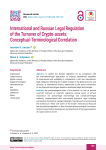
Статья научная
Objective: to assess the Russian legislation for its compliance with the international-legal approaches to shaping symmetrical regulation of crypto-assets and possibility to complement it with new international-legal categories reflecting the in-depth changes in the global economy and structure of international finance, determined by the broad introduction of new financial technologies based on distributed ledger technologies. Methods: the methodological basis of the research is a set of general scientific methods of scientific cognition, among which of utmost importance are special-legal (formal-legal and comparative-legal) methods, complemented with risk-oriented approach, legal modeling and juridical forecasting. Applied integrally, they allowed comprehending the architecture, “letter and “spirit” of the modern international financial law and national legislation in their conceptual-terminological correlation and to forecast further development and adjustment of the legal regulation of crypto-assets turnover. Results: it was found that there appears a stable trend in the crypto-assets turnover regulation, according to which “soft” law dominates among the law sources (this is especially notable in the sphere of international financial law compared, for example, with conventions or international treaties); at the same time, there is a strengthening trend of “fragmentation” of international law with regard to crypto-assets turnover; the authors mark inconsistency of the conceptual framework contained in international acts and in the Russian legislation, as well as the gaps in the regime of crypto-assets turnover at the level of national law; the trends and forecasts are presented referring to the development of international-legal regulation of the sphere of crypto-assets. Scientific novelty: consists, first of all, in a complex comparison, based on, among other aspects, the fundamentally new concepts of regulation of such progressive international-legal categories as cryptoasset, virtual asset, cryptocurrency, stablecoin, etc., some of them rarely used in the Russian legal discourse and actually never applied in legislation. Practical significance: the scientifically grounded proposals are formulated, aimed at improving the conceptual-terminological framework of the Russian legislation in the sphere of crypto-assets turnover, implementation of which will allow constructing a common legal space with the technologically most advanced states, will help to improve investment climate and financial attraction of the state; will improve the national-legal regime of crypto-assets turnover from the viewpoint of not only actual market demands, but also state security interests and improving competitiveness of the Russian legislation.
Бесплатно
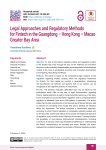
Статья
Objective: To look at the fintech regulatory policy and regulatory system in the Greater Bay Area through the lens of the Trilemma of Innovation doctrine in order to identify the applicability and extrapolation of existing legal models in the zone of accelerated economic and innovation development in Guangdong, Hong Kong and Macau. Methods: The article is based on the comparative legal research of the regulation regarding models, existing within the regulatory framework for fintech. For that matter we conduct a generalization, introducing the classification of methods and systems that, in our opinion, can be recognized as the Lego-like systems of instruments. Results: The research evaluates difficulties that may be faced by the participants within GBA on the way of legal harmonization regarding fintech. Special attention is paid to Hong Kong SAR, being one of the best-known examples of successful fintech regulation, and to comparing fintech regulation in Mainland China and in SAR (Macau, in particular). The author states that the last amendments to the financial law of Macau SAR also add an element of uncertainty, even though they aim to develop the situation within the framework. The author compares a technocratic approach, according to which fintech regulation is completely national (created only for the domestic market and reflects its structure) and traditional approach to regulation, a part of which is the Trilemma of Innovation. The latter implies the possibility of over-national (international) standardization, including in the form of soft law, which may eliminate the difference in understanding the fintech characteristics, its concepts and scope. Besides, the author analyses the correlation between the concepts of financial regulatory system and financial system of fintech regulation, extrapolation of the existing regulatory framework to the developing market of innovative technological solutions and their various models. The author highlights the regulatory response method, changing during the fintech market evolution, and applied, as a rule, together with other approaches. Scientific novelty: the article presents a comprehensive review of the different systems of fintech legal regulation in the Guangdong – Hong Kong – Macau Greater Bay Area, whose unique experience demonstrates various trajectories of the fintech market development in southern China within the “One Country – Two Systems” concept. Practical significance: the main conclusions and proposals resulting from the study are of significant interest for further research, regulatory policy and fintech regulatory system, as Mainland China and the special administrative regions of the Greater Bay Area use different approaches and methods of legal response that have no analogues in the modern world.
Бесплатно
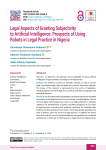
Статья
Objective: to determine the potential and acceptability of using artificial intelligence in legal activities according to the Nigerian law. Methods: the research is based on scientific analysis, as well as formal-legal, comparative-legal, historical-legal and systemic-functional methods. The scope of the research is represented by the norms of legislation, including expired normative legal acts, as well as scientific monographic and periodical literature. Results: It was found that artificial intelligence and robot lawyers are inevitable innovations in the legal practice of many countries, including Nigeria. The use of these digital technologies has proven to be highly effective in activities related to the administration of justice, providing assistance in four areas of legal services: consulting and guidance, searching for materials, data analysis and forecasting the trial results. Technology greatly facilitates the work of lawyers, given the amount of legal services. In addition, the author show that while the use of artificial intelligence may generally be considered justified, the involvement of robot lawyers in legal practice in Nigeria faces both legal and ethical barriers. The laws on legal education and legal practice in force in this country do not recognize robot lawyers as persons licensed to practice law in Nigeria. Robot lawyers must be given the status of a person before they can fully implement their potential in the legal practice of Nigeria. Scientific novelty: this is primarily due to the formulation of a research task to determine the possibility of a robot acting as a practicing lawyer within the legal framework in Nigeria. Practical significance: the conclusions formulated in the paper, namely, the inevitability of using artificial intelligence and robot lawyers in legal practice and the current legislation governing legal practice in Nigeria, will be useful when considering amendments to legislation in order to adapt it to the current level of digital technology development.
Бесплатно
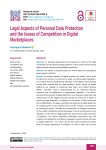
Legal Aspects of Personal Data Protection and the Issues of Competition in Digital Marketplaces
Статья
Objective: to develop approaches and proposals to improve the legal mechanisms for the personal data protection in the context of the evolving digital markets and the growing digital competition. Methods: the article is prepared based on formal legal and comparative legal research methods. Results: the unique features of digital markets are shown, which must be taken into account to achieve the goals of antimonopoly legislation. It is marked that the fundamental elements of the digital market include the big data concept and big data analytics, which, based on digital platforms, are capable of producing many direct and indirect network effects. The latter require understanding for an effective antitrust response and the application of appropriate legislation. The author proves that the growth of digital platforms as a business model and vital infrastructure of the digital economy should be viewed as a factor in improving legal regulation of relations in the sphere of data protection and confidentiality. The paper identifies the potential of digital platforms for assessing the current market power and the impact of competition on limiting this power. The data are considered as an integral component of the overall competitive market landscape. The current European Union regulation in the field of digital platforms and personal data protection is analyzed. The author identifies difficulties associated with the creation and application of effective regulations governing the activities of digital platforms. The article proves that antimonopoly authorities need to change approaches to analytics in order to take into account the distinctive features of digital platforms. It is noted that such changes may require legislative reforms and revision of procedures to match the rapid development of these markets and ensure that any potentially anti-competitive behavior is thoroughly investigated. Scientific novelty: the research contributes to the development of approaches to determining indicators of ensuring the personal data confidentiality under the digitalization of markets and to evaluating the effectiveness of antimonopoly legislation and its application in a new competitive environment. Practical significance: the results obtained can be used as a basis for improving antimonopoly and personal data protection legislation, as well as legal regulation of digital platforms in general.
Бесплатно
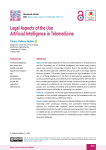
Legal Aspects of the Use Artificial Intelligence in Telemedicine
Статья
Objective: the rapid expansion of the use of telemedicine in clinical practice and the increasing use of Artificial Intelligence has raised many privacy issues and concerns among legal scholars. Due to the sensitive nature of the data involved particular attention should be paid to the legal aspects of those systems. This article aimed to explore the legal implication of the use of Artificial Intelligence in the field of telemedicine, especially when continuous learning and automated decision-making systems are involved; in fact, providing personalized medicine through continuous learning systems may represent an additional risk. Particular attention is paid to vulnerable groups, such as children, the elderly, and severely ill patients, due to both the digital divide and the difficulty of expressing free consent. Methods: comparative and formal legal methods allowed to analyze current regulation of the Artificial Intelligence and set up its correlations with the regulation on telemedicine, GDPR and others. Results: legal implications of the use of Artificial Intelligence in telemedicine, especially when continuous learning and automated decision-making systems are involved were explored; author concluded that providing personalized medicine through continuous learning systems may represent an additional risk and offered the ways to minimize it. Author also focused on the issues of informed consent of vulnerable groups (children, elderly, severely ill patients). Scientific novelty: existing risks and issues that are arising from the use of Artificial Intelligence in telemedicine with particular attention to continuous learning systems are explored. Practical significance: results achieved in this paper can be used for lawmaking process in the sphere of use of Artificial Intelligence in telemedicine and as base for future research in this area as well as contribute to limited literature on the topic.
Бесплатно
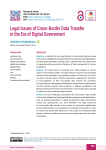
Legal Issues of Cross-Border Data Transfer in the Era of Digital Government
Статья
Objective: to identify the main legal factors of cross-border data exchange in the context of digital technology proliferation and government digitalization, including legal guarantees, security issues, cybersecurity risks, approaches to regulating and improving the efficiency of data management in various jurisdictions. Methods: the study relies on synthesis and critical analysis of various aspects of the stated problem, including analysis of primary and secondary sources. By the example of the regulatory policies of China, the US, the EU and EAEU member states, different approaches regarding the restriction or encouragement of free cross-border data transfer are compared. A comprehensive meta-analysis and literature assessment provided insights into the methods used for data protection in different jurisdictions and allowed outlining the framework and directions of the public policy required for effective cross-jurisdictional data transfer. Results: the main challenges associated with cross-border data transfer in the context of digital technology proliferation and government digitalization, such as growing inequalities in digital development, legal uncertainties, privacy and cybersecurity, etc., were identified. The legal framework of cross-border data transfer in the context of government digitalization and its implementation were analyzed. It contributed to the search for ways to improve the government efficiency in the context of transnational data transfer, including rendering services and promoting openness and public participation. Scientific novelty: based on the analysis of various jurisdictions’ approaches to legal, security and sovereignty issues caused by transnational data transfer, the author reveals the role and applicability of international law, as well as the unique challenges arising in the member states of the Eurasian Economic Union on the way to the formation of transboundary trust space. Practical significance: the study of these issues may help various public agencies, first of all, governmental and legislative bodies to the elaborate well-targeted political and legal decisions, aimed at achieving a balance between data availability and data security, between the effectiveness of public administration and respect for the human rights. The results obtained will also be of importance for other subjects of relations in cross-border data transfer and regulation of these relations.
Бесплатно
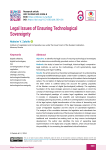
Legal Issues of Ensuring Technological Sovereignty
Статья научная
Objective: to identify the legal issues of ensuring technological sovereignty and to determine scientifically grounded vectors of their solution. Methods: the study is based on formal-legal, historical-legal, comparative-legal methods, as well as the methodology of soft systematicity, legal forecasting, and legal modeling. Results: the article presents a theoretical and legal approach to understanding sovereignty and differentiating its types. Under modern conditions, a significant role is given to the independence and autonomy of the state in the technological sphere. The correlation of digital and technological sovereignty is considered; the latter notion is outlined taking into account the gaining popularity of the Western concept of digital (technological) solidarity. The regulatory foundation of the state strategic autonomy is legal regulation, in which the concept of technology-centrism has been firmly established in recent years. The technological paradigm of modern legal regulations was identified. It consists in strategizing the scientific and technological innovations in strategic planning documents, as well as in sovereignization and cyclization of the legal sphere, digital transformation of the culture of lawmaking and law enforcement, technologization of the legal language, expansion of the scope of legislative regulation and the volume of subordinate legislation. The analysis of the correlation between the legislative and subordinate law levels of technological positioning of the Russian Federation in strategic areas has allowed to emphasize the important systemic interrelation of the involved traditional and innovative law-making tools as they ensure technological development. The author also identifies the risks of expanding legal experimentation in the digital area of public relations, which should exclude the possibility of circumventing the established critical limitations. Scientific novelty: the work forms a theoretical and legal model of ensuring technological sovereignty, which is of strategic importance for the preservation of the Russian Federation sovereignty in its classical understanding as the main and most important feature of the state. Practical significance: the results can be used in law-making activities of public authorities to create legal mechanisms for research, development and implementation of critical and end-to-end technologies and the production of high-tech products based on them in order to ensure national security of the Russian Federation.
Бесплатно

